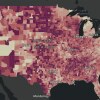Long Beach's Vaccine Gamble Is Paying Off for Frontline Workers

The following article was originally republished Feb. 10, 2021 through a collaboration with KPCC and LAist.
Story by Sharon McNary
In the majority of Southern California, the people eligible to receive a Covid-19 vaccine are an exclusive group. Phase 1A — seniors and health care workers only.
A few places, however, are already vaccinating the second group, Phase 1B, which includes essential workers in education, emergency services, and the food industry.
One such place is the city of Long Beach (Riverside County is also ahead).
In early February, thousands of food service workers lined up at the Long Beach convention center to get their first shots, while firefighters, 911 dispatchers and other emergency service personnel headed to fire stations to get their doses of the vaccine.
Meanwhile, some 5,000 campus faculty and other employees at Cal State Long Beach have begun getting vaccinated at an open-air clinic that opened in a large parking structure on campus. It's what they call a "closed pod," open only to campus workers. It's able to give about 300 vaccinations per day right now, assuming the vaccine supply continues to arrive.
Fatou Olshanski is the director for student housing and resident life at Cal State Long Beach.
"I'm ready to get it done," she said with an exhausted-sounding laugh from the passenger seat of her black SUV, as she checked in to the vaccine center. The housing she oversees has been mostly empty since March, when the pandemic forced most classes online.A campus staffer directed Olshanski to drive up the parking ramp and to pull into a stall to get her vaccine. A quick consultation with a nurse, and then with the on-site doctor about an allergy, and she was cleared to get the shot.
Immense Joy
If Olshanski worked in just about any other city in California, she would still have to wait a month or more to get vaccinated. But Long Beach has its own health department, robust enough to serve a city of nearly a half-million residents, and nimble enough to change gears quickly to accommodate variations in the vaccine supply.
"I get immense joy watching people get vaccinated. I love it," said Long Beach Mayor Robert Garcia.
"People also sometimes don't realize how big the city is," Garcia said. "We're roughly the same size as Atlanta, Georgia. So this is a huge city. It's a huge health department, and it's allowed us to make decisions faster, quicker, fix problems."
The city's health officials worked from an assumption of abundance of vaccine, not scarcity, when deciding how to use the supply of vaccine allocated to the health department.
"We made some decisions early on to not hold on to supply, but to run out as fast as possible. And that's helped us move along really quickly," Garcia said.
Taking a Risk

He acknowledges that it was a somewhat risky decision. People who got their first shots might be at risk of not getting that second shot at the correct time weeks later if the vaccine supply dried up. But so far, the supply has been coming in.
Garcia said it would have been riskier to wait. Long Beach's 700 COVID-19 deaths include his own mother and stepfather who died before a vaccine became available.
"Because I've also lost both my parents, I certainly feel like every vaccine that we get out is a potential life saving opportunity," Garcia said. "I also think my mom would have been one of the first ones to get vaccinated because she was a health care worker."
So far, about 50,000 Long Beach residents and people who work in eligible Phase 1A and 1B jobs in Long Beach have been vaccinated, either at city clinics or other medical offices within the city.
The next group in line under California's vaccine rollout plan are other frontline essential workers, including those in manufacturing, transportation, facilities and services. It also includes jail and prison inmates, and people who are unhoused.


